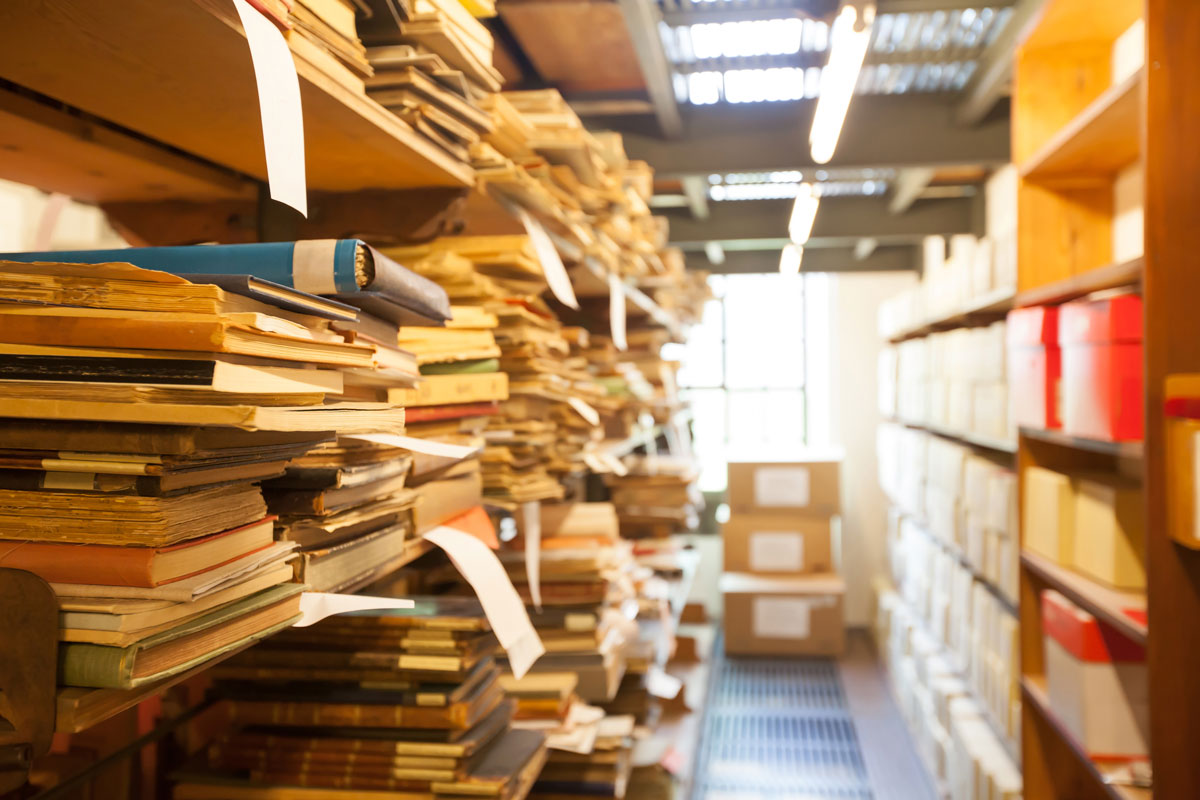
by Marcia Spicer
Are you a proud owner of historical material written by or to famous individuals? Perhaps your collection isn’t recognizable to the public but impacts your family or community. Preserving these documents for future generations can be a daunting task for the new or unprepared collector. Too often, collectors inheriting these materials are confronted with originals that have already sustained damage that renders them incomplete or illegible.
How different could the future of these documents be if previous owners had taken steps to preserve them from the beginning?
It’s never too late to start treating your collection with preservation in mind. Here are some tips for protecting and preserving those documents, whether at home, in a library, or in storage. Many of the techniques outlined below also move you toward proper digital preservation, which allows your collection to be shared with the world while keeping the originals safe and in the best condition.
Protect: The Basics
If you do nothing else to protect your collection, follow these general guidelines for handling old documents when working with your historical collections.
Wash hands.
When documents must be handled, use only with hands washed in soap and water. Pause your research to wash your hands again whenever they feel dirty. The dirt and oil on your hands can damage the documents and build up over time, which will obscure text. White cotton gloves are no longer recommended because they can reduce dexterity. If gloves must be used, as in the case of handling photographs, nitrile gloves are preferred.
Support the entire document.
Whether you’re working with a heavy book, a large map, or a single piece of paper, be sure to use the right support to keep it from falling apart when lifted. For books, wedges and cradles provide support for covers and spines in danger of damage if opened flat.
Don’t crush the document.
Compromised areas like folds or binding can crumble under weight and pressure, but specialized storage containers are designed to prevent this deterioration.
Preserve: Long-Term Protection
What steps can be taken to preserve originals for posterity? Whether you’re keeping your collection archived in cold storage or a room in your house or office, there are some best practices to address.
Boxes.
Archival boxes must be acid-free and lignin-free, and individual pages should be buffered to avoid damage if the boxes are bumped.
Humidity control.
Excess humidity can cause mold and rot, which will eventually destroy documents. Climate-controlled storage is optimal, but something as simple as a modified dehumidifier can make a big difference. Humidity should be between 30% and 50%, as long as the temperature and humidity are stable and don’t fluctuate.
Temperature control.
Heat can cause deterioration, and even if humidity levels and light exposure are controlled, insects love heat. Be sure your documents are stored in a climate-controlled area between 68-70°F. A great option for long-term humidity- and temperature-controlled climates is salt mine storage.
Be insect and rodent-free.
Insects and rodents love to eat, burrow, and shred paper for nests. Collectors should be sure that display cases and boxes are sealed to avoid damage done by these creatures.
Avoid light exposure.
Since light causes deterioration, documents are best stored in a room with no windows or with covered windows, especially if displayed. Using UV-coated glass for displays can also help reduce deterioration.
Consider digitizing.
Let’s be frank, accidents can happen. The best way to avoid the complete loss of a document, even stored correctly, is to digitize. If something happens to a physical collection that has been digitized, such as flood or fire, history will not be lost. Digitizing keeps the originals protected while allowing digital copies of them to be used far beyond the geographical restrictions of a physical document.
If collectors want others to be able to enjoy the collection—or if the collection will be used for research—the finger marks, tears, and damage from light that come with handling the documents can be reduced or avoided entirely.
Digitize: The Ultimate Insurance Policy
If you have a collection that you can’t display, use for research, or share… why are you collecting it? This is a question that many collection owners ask themselves before deciding to digitize.
What is digital preservation?
Digital preservation can be used to display, share, and organize a large amount of data, to create search options, and to help preserve original documents by keeping them safe from over-handling. Digital preservation is more than scanning the document; it includes active archiving and document management. Once digitized, documents can be displayed on a custom website or organized into a document management system that allows users to access the collection with ease. The following is a list of steps that help make digitizing a powerful tool for collectors.
1. Know the scope of the project.
Digitizing starts with examining the documents to catalogue them and note any damage that might need to be remediated digitally. Examining each document will also give collectors a better grasp of what is a priority for digitization and what is okay to let go of permanently.
2. What is the goal of digitization?
Think of the big picture. This is an opportunity for you to envision how the digital library will be used. Who do you want to reach? Think about how to organize the documents—on a website or simple electronic filing system—and what is the best way to list the files for quick search—date, author, both, or something else entirely.
3. Scan.
The next step is to take high-quality scans of each page. A larger flatbed scanner might be necessary for maps and non-standard-size paper. Be wary of self-feeding scanners. They may operate quickly, but they are prone to skipping pages and can damage paper.
4. OCR for searchability.
Optical character recognition (OCR) software digitally reads text on an image and converts it to characters that can be searched. It’s always prudent to have a real human check for errors because software is far from infallible, and the impact of poor OCR can have widespread effects. OCR software might not recognize characters such as l when it looks like the number 1 thanks to font irregularities. This throws off searches; for example, a search for “Lewis and Clark” may result in fewer accurate results if the computer doesn’t know it’s a match to “Lewis and C1ark.”
5. Insert metadata.
Metadata is what refines searches, making digital searches incredibly efficient. Inserting metadata includes adding authors, copyright information, and even faceted information like keywords or topics discussed. This allows the search to provide results for an author or date instead of only a particular phrase or title as it is printed.
6. Back up the collection.
Once the documents are digitized, it’s prudent to back them up. The best system for backups is at least twofold: back them up to a hard drive and to cloud storage. That way if the hard drive gets damaged or if your internet connection is lost, one backup will always be available.
7. Share.
It’s finished! The documents are digitized and can now be shared. A private file system can be used for research or shared to an internal network, while a website can make the documents available worldwide.
Whether documents are preserved physically, digitally, or both, preservation means that the information, knowledge, and experience of the past is readily available for the future.


